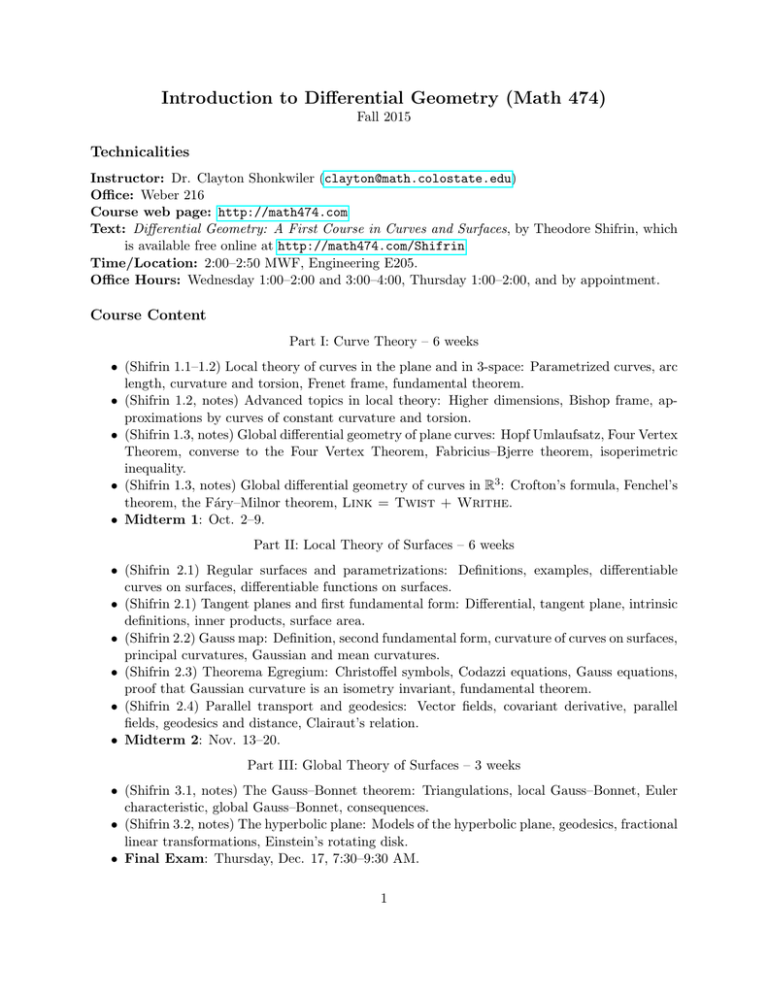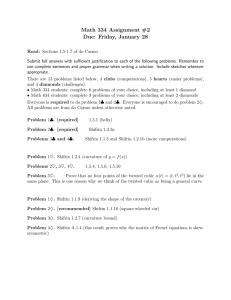Introduction to Differential Geometry (Math 474) Technicalities
advertisement

Introduction to Differential Geometry (Math 474) Fall 2015 Technicalities Instructor: Dr. Clayton Shonkwiler (clayton@math.colostate.edu) Office: Weber 216 Course web page: http://math474.com Text: Differential Geometry: A First Course in Curves and Surfaces, by Theodore Shifrin, which is available free online at http://math474.com/Shifrin Time/Location: 2:00–2:50 MWF, Engineering E205. Office Hours: Wednesday 1:00–2:00 and 3:00–4:00, Thursday 1:00–2:00, and by appointment. Course Content Part I: Curve Theory – 6 weeks • (Shifrin 1.1–1.2) Local theory of curves in the plane and in 3-space: Parametrized curves, arc length, curvature and torsion, Frenet frame, fundamental theorem. • (Shifrin 1.2, notes) Advanced topics in local theory: Higher dimensions, Bishop frame, approximations by curves of constant curvature and torsion. • (Shifrin 1.3, notes) Global differential geometry of plane curves: Hopf Umlaufsatz, Four Vertex Theorem, converse to the Four Vertex Theorem, Fabricius–Bjerre theorem, isoperimetric inequality. • (Shifrin 1.3, notes) Global differential geometry of curves in R3 : Crofton’s formula, Fenchel’s theorem, the Fáry–Milnor theorem, Link = Twist + Writhe. • Midterm 1: Oct. 2–9. Part II: Local Theory of Surfaces – 6 weeks • (Shifrin 2.1) Regular surfaces and parametrizations: Definitions, examples, differentiable curves on surfaces, differentiable functions on surfaces. • (Shifrin 2.1) Tangent planes and first fundamental form: Differential, tangent plane, intrinsic definitions, inner products, surface area. • (Shifrin 2.2) Gauss map: Definition, second fundamental form, curvature of curves on surfaces, principal curvatures, Gaussian and mean curvatures. • (Shifrin 2.3) Theorema Egregium: Christoffel symbols, Codazzi equations, Gauss equations, proof that Gaussian curvature is an isometry invariant, fundamental theorem. • (Shifrin 2.4) Parallel transport and geodesics: Vector fields, covariant derivative, parallel fields, geodesics and distance, Clairaut’s relation. • Midterm 2: Nov. 13–20. Part III: Global Theory of Surfaces – 3 weeks • (Shifrin 3.1, notes) The Gauss–Bonnet theorem: Triangulations, local Gauss–Bonnet, Euler characteristic, global Gauss–Bonnet, consequences. • (Shifrin 3.2, notes) The hyperbolic plane: Models of the hyperbolic plane, geodesics, fractional linear transformations, Einstein’s rotating disk. • Final Exam: Thursday, Dec. 17, 7:30–9:30 AM. 1 Prerequisites Students are expected to have a solid grounding in multivariable calculus and linear algebra, equivalent to the content offered in MATH 261 and MATH 369. Course Goals Students will develop a deep understanding of the differential geometry of curves and surfaces, including the various relevant notions of curvature. This will require a synthesis of geometric visualization, symbolic and numerical calculation, and rigorous reasoning and communication. At the end of the course, students should be prepared for a graduate course in the differential geometry of manifolds. Additional Resources In addition to the official text and the course notes, these books may also be useful references: • • • • • Differential Geometry of Curves and Surfaces, by Manfredo P. Do Carmo Elementary Differential Geometry, by Barrett O’Neill Elementary Differential Geometry, by Andrew Pressley Differential Geometry of Curves and Surfaces, by Thomas Banchoff and Stephen Lovett Geometry from a Differentiable Viewpoint, by John McCleary Homework Homework will be collected every week or two. Each assignment will consist of 6–8 problems, from which you will select 4 to turn in. Homework is an important part of any math class, as it is impossible to learn mathematics without actually doing mathematics. The goal of the assignments is to deepen your understanding of the concepts, tools and techniques discussed in class, as well as to give you the opportunity to practice explaining your mathematical thinking. The importance of effective communication is vital: knowledge without the ability to communicate that knowledge is of limited value. As such, to get full credit on a problem your solution must be clear and well-written. Homework must be stapled with your name clearly written at the top. What you turn in should be a final copy: it should be neat, legible, and well-organized. If I can’t read or understand your work you won’t receive any credit. Late homework will not be accepted, so you should turn in whatever you have completed on the due date in order to get credit for it. I strongly encourage you to work on solving homework problems with your fellow classmates. However, the work you turn in must reflect your own knowledge and understanding and not that of anyone else. Therefore, you must write up your solutions by yourself. Exams There will two take-home midterm exams and an in-class final. You will have approximately 1 week to do each of the take-home midterms; the first will be due on October 9 and the second on November 20. The final exam will occur in Engineering E205 (our regular classroom) from 7:30–9:30 AM on Thursday, December 17. 2 No make-up examinations will be given in the course. Grading Your final grade in the course will be determined by: Homework and Class Participation: 50% Exams: 50% Here’s how the grading process works. First, I compute an overall course grade for you on a scale of 0–100 by combining your exam and homework grades using the weights above. Then, I rank everybody in the class in order by their score and assign cutoffs for ‘A’, ‘B’, ‘C’, and ‘D’. Generally these are somewhat lower than the traditional 90, 80, 70, and 60. When setting the cutoff I consider the students immediately above and below the line and try to take into account improvement and other circumstances. That being said, the list is never, ever reordered. Regardless of other circumstances, a better score in the class should always earn at least as good a letter grade. Ultimately, I can only grade the course based on what you have actually done. Attendance You are expected to attend class every day, to participate in class, to read the textbook, and to do the homework. Academic Honesty As a Colorado State University student, you have agreed to abide by the University Policy on Academic Integrity (General Catalog – 1.6, pages 7–9) and by the Student Conduct Code (http://www.conflictresolution.colostate.edu/conduct-code). All academic work must meet the standards described in the Academic Integrity Policy. At a minimum, violations will result in a grading penalty in this course and a report to the Office of Conflict Resolution and Student Conduct Services. Lack of knowledge of the academic honesty policy is not a viable explanation for a violation. Questions related to coursework and the academic honesty policy should be discussed with the instructor. You are encouraged to discuss homework problems with your classmates, but the work you turn in must be your own, and in particular you should write up your final solutions independently. Additional help If I were a perfect teacher, you could learn everything you need to know just by going to class and doing the assignments. Unfortunately, I am not a perfect teacher, so there’s a good chance that, at some point, you’ll find yourself confused, stuck or otherwise frustrated by the material or the course. If you do, ask for help! Come to office hours, send me email, ask me questions after class. Also, your fellow classmates are a great resource! Odds are that, for any question you have, there’s someone in the class who can answer it, so don’t be afraid to ask. Even the simple process of explaining why you’re stuck to someone who is just as confused as you is often enough to make things clearer. Just be sure to return the favor when you get the chance to help someone else. 3 If you need additional help or outside resources, please ask and I will be happy to try to give suggestions. Accommodations If you think you may need accommodations in this course due to the impact of a disability please meet with me privately during the first week of class. You should also contact the Resources for Disabled Students office (http://rds.colostate.edu) to confirm your eligibility for appropriate accommodations. Doing so early in the semester will help prevent unnecessary inconvenience. Copyright All of the course materials, including tests and exams, are copyright by the instructor, even if the c symbol does not appear on them. You may not upload or post copies of these materials to the web without explicit written permission. Disclaimer The course syllabus is a general plan for the course; deviations announced in class may be necessary. 4
